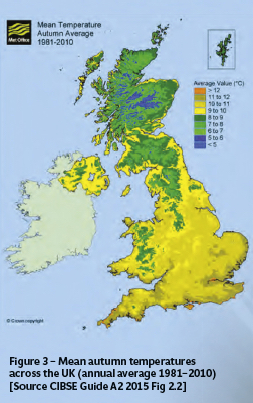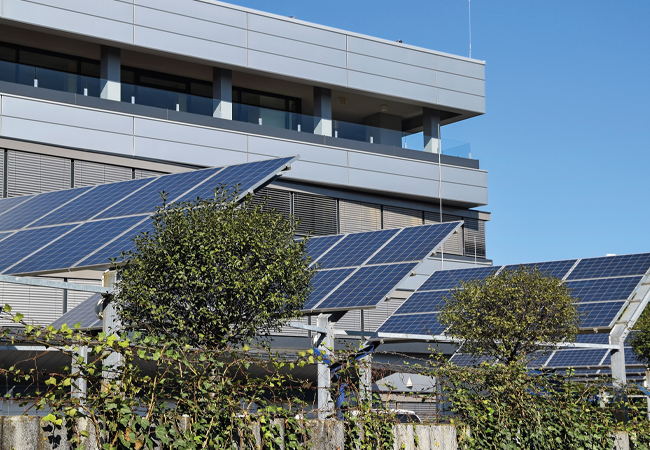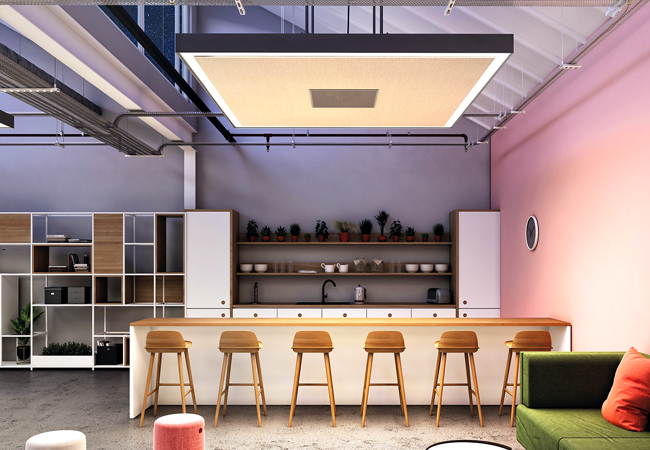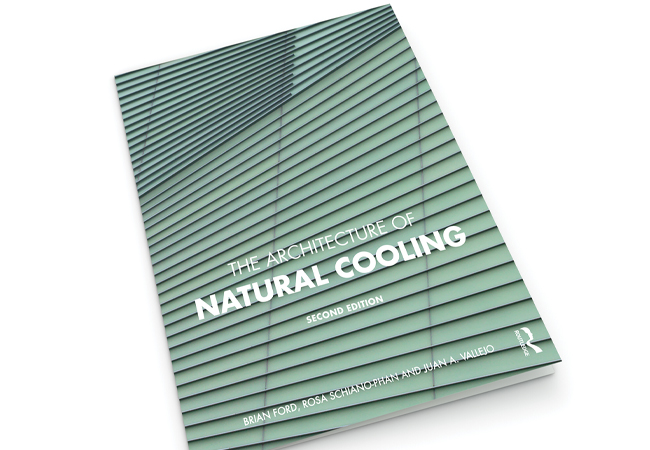The CIBSE guide to Environmental design has had a major upgrade for the first time in nine years, and large parts of the edition have been revised.
CIBSE Guide 2015 aims to define the main criteria for design in terms of comfort and health, and to set out appropriate internal and external design conditions. Under the chairmanship of Derrick Braham, Guide A describes a logical process for engineers to deliver comfortable, productive, and low environmental impact buildings, while considering the consequences of climate change.
This is the first of a series of three articles that will provide an overview of the new Guide A. It will focus particularly on areas that have changed significantly since the 2006 edition, and is essential reading for anyone involved in the design, procurement and operation of buildings.
As with all key CIBSE publications, this Guide can be downloaded free of charge by CIBSE members from the CIBSE Knowledge Portal www.cibse.org/knowledge
Chapter 0: Quality in environmental design
The all-new Chapter 0 is designed both to provide an introduction to Guide A and to set out an holistic design routemap and quality assurance process. Principal author Foroutan Parand sets the bar high in the introductory paragraph by proclaiming that the Guide is the premier reference source for such activity. More humbly, and realistically, he subsequently reflects that the guide is not to be taken as being exhaustive, or definitive – as with all engineering challenges, the appropriate application is dependent on professional judgement.
A flowchart provides the structure for the guide. It links functional stages, with the appropriate chapter. For example, ‘define the amount of fresh air ventilation rates required for each space’ is in chapter four. This simple but effective diagram allows the more casual reader to determine a first path through the 290-page guide quickly.
Although the guide is designed for use anywhere in the world, the first part of the chapter concludes with example legislation and regulations that are specific to the UK.
The more significant part of the new chapter covers the design process, design calculations quality plan, sources of uncertainty, user issues, and performance assessment methods. The whole chapter is developed around the core need to ensure a properly quality assured design process.
The design process sets out the generic stages of design – concept, scheme, and detailed design – and attempts to encapsulate the overall design questions and calculation methods that might deliver the required output for each stage.
By exploring the main elements in the design flow (as shown in Figure 1) the design calculations quality is explained through a 10-step action list. This considers how each stage might be assured by rigorously maintaining appropriate methods and checks. So, for example, this stepped approach could be applied to individual design scenarios such as ‘what size openings should be used for natural ventilation in a building?’

This chapter highlights the need for engineers properly to interpret and understand calculations and modelling. It provides links to relevant CIBSE publications that can guide the designer in determining areas of uncertainty and degrees of risk.
With the endemic application of computer software, the danger of both poorly-qualified and ill-informed ‘operators’ is discussed, and the necessity for appropriate quality assurance (QA) reinforced.
The chapter concludes with a very brief introduction to the concept of ‘Performance assessment methods (PAM)’ that was developed within IEA Annex 21 (Environmental Performance) as a means of documenting a QA procedure when applying a particular calculation method. An example application of a PAM for a ‘Calculation of summertime temperatures using the CIBSE cyclic method’ can be downloaded from
www.cibse.org/Guide-A/pdfs
Chapter 1: Environmental criteria for design
This chapter sets out to include the best available information for the optimal specification of environments in and around buildings. It provides a basis for other chapters in Guide A and other CIBSE documents. Since the publication of the previous edition there has been a greater acceptance of the importance of both adaptive and integrative aspects in the assessment of a comfortable, healthy and productive environment.
The preamble to this chapter strongly aligns these areas of contemporary understanding with a more closely argued, and referenced, evaluation of the physiological and psychological determinants for wellbeing and comfort. Chapter 1 has been radically overhauled for the 2015 edition with reordering and revisions of many sections.
The explanation of thermal comfort is completely revised and benefits from the insight of the chapter’s principal author, Fergus Nicol, who has undertaken a significant number of studies in this area. The section describing the adaptive thermal comfort model has elevated prominence at the beginning of the chapter – where it is explained in some detail – considering aspects of occupant expectation, control and clothing as well as the temporal changes in conditions that provide opportunity for maintaining more sustainable internal conditions. Noting that there is potential deviation in the expectation of comfort – as predicted by the Predicated Mean Vote (PMV) and Predicted Percentage of Dissatisfied (PPD) procedure – from that experienced in ‘daily life’, is a significant new stance for the guide.
Possibly the most used and oft-referenced table in CIBSE Guide A is Table 1.5, ‘Recommended comfort criteria for specific applications’. This has been revamped and expanded to accommodate more room types particularly for institutional and commercial buildings such as educational, health care, hotels, retailing and television studios.
A subtle change in terminology prepends the word ‘customary’ to the column headers for the winter and summer operative temperatures. This, together with the associated codicil, offers a long-needed clarification that the ‘daily mean operative temperature for comfort is likely to be somewhere within the range given, and that the variation of +/-1K within the day would attract little notice, while a variation of +/2K will be noticed and may cause some complaint at the extremes’. This pragmatism will empower designers, clients and operators to be more realistic in their expectations. This table also provides more detailed noise criteria than in the 2006 version.
Overheating has a more prominent position in the chapter. Some of the 2006 content on overheating has been adjusted and reordered and a new section ‘Identifying the overheating of buildings in Europe’ explains some of the findings of the CIBSE ‘Overheating task force’ and promotes methods for establishing and avoiding the risks of overheating in mechanically and naturally ventilated buildings, which are developed in more detail in CIBSE TM52 Limits of Thermal Comfort: Avoiding Overheating.
An innovative addition is the section on ‘Outdoor thermal comfort’ that reaches beyond the traditional confines of the building. It examines the factors that determine comfort in external spaces that are associated with the building, such as courtyards. These spaces are increasingly popular in contemporary building designs.
The section includes a discussion on adaptive comfort and the relationship between the building and its immediate microclimate, together with suggested design strategies to create an environment that delivers an effective and usable outdoor space. Meeting an individual’s comfort needs in the outdoor space is likely to be dependent on geographic location, the season and culture (see figure 2).

The lighting coverage in the ‘Visual environment’ section is briefer than in the previous edition – predominantly considering comfort rather than task-related needs. This is presumably since the referenced SLL Guide to Lighting is able to provide the necessary comprehensive coverage of concepts such as disability glare and directional effects.
The two final sections covering ‘Noise’ and ‘Vibration’ have been updated, reordered and significantly expanded. They begin with clear identification and description of the units and parameters that define the human aural, and vibratory environment, continuing with the relevant aspects of human perception, and response to noise and vibration. Recommended measurands are discussed, followed by a review of noise assessment guidance that is far more extensive than in the previous Guide. The noise section includes a useful commentary on the application of extended noise criteria contained in the expanded Table 1.5.
The contents of the brief section that concluded the 2006 Chapter 1 on ‘Electromagnetic and electrostatic environment’ has been appropriately removed and passed to chapter 8, ‘Health issues’.
The appendices for Chapter 1 deliver a nostalgic detour with the inclusion of a program listing for PMV written in, what some may regard as, the antediluvian BASIC language – however the logic and simplicity is still as illuminating as it was back in the days of the BBC Model B computer.
Guide A can be downloaded free of charge by CIBSE members from the Knowledge Portal at
www.cibse.org/knowledge
Chapter 2: External design data
The principal author Geoff Levermore has overseen this comprehensive update with more recently sourced climate data evident throughout the chapter to underpin the evaluation, modelling and simulation of buildings. A selective cull of some previously included material has been designed to specifically leave information applicable to support other sections of the guide. Some of the derivative illustrations – for example, tables of degree-days and graphical representations of bin weather data – have also been removed.
To provide improved context for the included UK climate data sets, each of the 14 sites have more extensive climate descriptions. A group of colour-shaded maps (as shown in the example in Figure 3) graphically indicating the seasonal mean temperatures, provide a complementary view of the climatic differences across the UK.

Many of the data tables associated with Chapter 2 are not printed but are downloadable from the CIBSE website
(www.cibse.org/Guide-A/pdfs). This includes climatic design information for 250 worldwide locations – providing more detail than the previous edition – with additional data such as precipitation, degree-days and clear sky solar irradiance, as well as a wider set of ranges of monthly cumulative frequencies of occurrence of wet and dry bulb temperatures.
Solar data has been revised. The sol-air temperature and long wave loss equations have been simplified and more clearly introduced. Cumulative frequency data for global and diffuse iIluminance (as used for lighting design assessment) is now included for all 14 UK sites.
Wind frequency data is presented in a seasonal format to assist in the more realistic evaluation of natural ventilation that, until now, was restricted to relating predicted wind speeds with annual bands
of external temperatures.
Climate change data has been updated from the UK Climate Projections (UKCP09) from the Met Office Hadley Centre climate prediction model (HadCM3). There is an explanation of how predictions have been derived, and commentary on how climate is likely to be affected. The data produced is probabilistic (a combination of probability that deals with uncertainty and deductive logic) reflecting uncertainty in projected climate changes. Tables at different probabilistic levels are provided, as well as references to Probabilistic climate profiles (ProCliP) graphs to appreciate the temperature rises through the century for different emissions scenarios (defined by the IPCC).
The urban heat island (UHI) data has been updated to give the UHI effect on the City of London – and various distances out from it – compared to Heathrow. Manchester UHI data is also provided for the first time.






